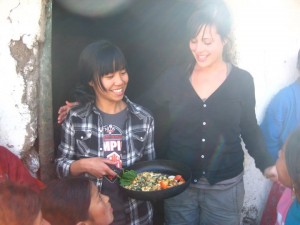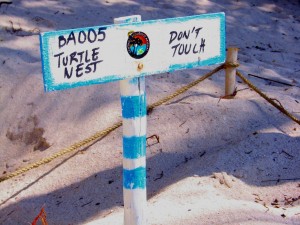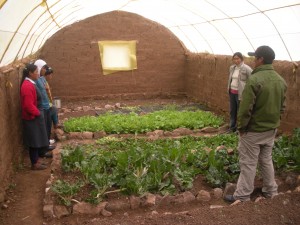The AASD Vlog – Connecting the Sacred Valley
Check out what the NGO Network Team has been up to this summer, pretty cool stuff.
Food For Thought
The nutrition and cooking classes have come to an end. I feel proud that we were able to start the conversation about nutrition in specific connection to the greenhouse. I see this as the beginning and hope to see more partnership with other organizations and schools to further the knowledge of nutrition and cooking of vegetables from the greenhouses.
The “Quick-fire” challenge didn’t go exactly as we expected but after two months in the Sacred Valley, if we have learned anything it is flexibility. The kids really made tasty food. Their memory of the specific nutrition associated with each vegetable varied, however they knew where to find the information in their books. Only one of the four teams made their own recipe and the others used recipes that we already made in class. We made every team a winner of a different category: Best Knowledge of Nutrition, Most Creative, Most Nutritious, and Best Rendition of a Recipe. All the kids earned a certificate signed by yours truly (Executive Chef) and Tina. They were really happy, especially with their prizes: knives, wooden spoons, pots, pans, and spatulas.
The director of the school asked when we would come back. Hopefully we can come back next summer and teach with more MIIS students. This program has so much potential and so much room to grow and demonstrates the sustainability of our model. I am going to miss these kids but hope to see them on Top Chef, the Peru version. ~ Jeanne
Srebrenica: Fighting to Survive
Srebrenica is not only a town, but also a reminder of the worst atrocity during the Bosnian war. It is the town that suffered losses unimaginable to anyone who did not go through it. While it once was rich in natural resources, it has now become a struggling and mediocre façade of what it once was. The population was halved and only a handful of the bravest people returned to their hometown.
For the past few days, Julia (the other Advocacy Project Peace Fellow) and I have been interviewing women about their needs and wants for the new BOSFAM center in Srebrenica about what services they use, what they would use, what they need, etc. One question that I look forward to hearing the response to is: why did you come back to Srebrenica? With the everlasting memory of your closest relatives buried deep in a cemetery in Potocari, the past is haunting. Houses are overtaken by trees and stray dogs. Graves litter the hillside. Buildings lie empty. Almost without exception, each woman, no matter her age, always answers the question in the same way. Srebrenica is my home. It is my town and I will not let someone else’s stupidity ruin the place where my best memories are. Each time, I am stunned by the deep connection that this now small town has instilled in so many. What makes it so special?
Last week I spent the night at an international peace camp in the Bosnian wilderness. I had expressed interest in seeing the camp and soon thereafter I was promptly gathered and placed into an old jalopy with two strangers and was racing up a dirt road in the middle of nowhere. On one side of us was a vertical wall of a mountain and below us I could see the biggest canyon in Europe with a green river that snaked through the lush green mountains. The view was breathtaking.
The camp was a collection of 10 UNHCR tents and a few wooden structures and no one around for miles. I was in awe of the pure natural beauty and simplicity of what stretched out around me for as far as I could see. At night as we sat around a fire of freshly chopped wood, I was stunned and humbled by the sheer number of visible stars above me.
I started a conversation with the camp’s owner and my chauffeur, Hakija. He told me that he started the camp for two reasons: to initiate a dialogue between the Serbs and Bosnian Muslims and to reinstate Srebrenica’s fame as a tourist destination in the Balkans and beyond. He explained that because this was the first year of its operation, dialogue was not something to be pushed, but rather a latent, secondary goal for now.
Drinking homemade milk and sitting on the edge of the Drina River, I finally understood the point that Hakija was trying to prove. Srebrenica is beautiful. The land is home to some of the best berries I have ever tasted, the dirt houses minerals such as zinc and silver, and there is even a spring with waters that are famed to have healing powers – a few decades ago, this potent and mineral-rich water was bottled and sold in stores throughout the former Yugoslavia. Most importantly, the local people I have met have been extremely kind and warmhearted.
As I near the end of my summer in Bosnia, I wonder why I haven’t spent more time in this town. The first time I visited, I came for a few hours to meet the women who work here and then went back to Tuzla. The second time, I was here to remember the 8,000 lives that were taken from Srebrenica.
After my hike up to the Crni Guber to partake in the power of the magical waters and the rest of my experiences here, I understand. I can see what drew people to this town. While there isn’t the hustle and bustle of the silver mining town from the past, there is a semblance of the vibrant community beneath the surface but suffocated by a bloody reputation. Beneath the pain of families who endured rape and genocide, the soul of Srebrenica is struggling to stay alive and fights to not become a defunct ghost town. I hope that for Hakija’s sake and for Srebrenica’s sake people will see the town of Srebrenica for what it is and not for what it was.
Emily
The AASD Vlog – Greenhouse Project Evaluation

Camino de Tortugas, Akumal
Hay ocho especies de Tortugas en el mundo, de las cuales siete visitan a la costa Maya y dos especies anidan en Akumal. Las tortugas recién nacidas tienen que luchar para vivir en sus primeros minutos de creer. El camino de una tortuguita es muy peligroso porque hay muchos predadores de las tortugas como iguanas, gaviotas, y mapaches, que intentan cazarlos en su camino al mar. Además como las tortugas marchan hacia la luz para saber cual dirección a caminar, pero con el desarrollo del sector turismo y específicamente con los restaurantes y hoteles es muy fácil para las tortugas perderse en el camino.
El liderazgo del “programas de las tortugas” consiste en acompañar ese camino que las tortugas hacen cada noche durante la temporada de nidificación. El programa empieza con un video que explica información básico de las tortugas y el proceso de anidacion. Luego, a las nueve empiza el camino por la playa para verificar los nidos que ya han identificado. Cada nido está protegido con unas señales que avisan al publico que en ese lugar hay un nido de tortugas. En nuestro camino por la playa hemos visto 10 nidos. Llegando a la mita de una playa ahí nos hemos encontrado con una “Green Back Tortuga” buscando un espacio para poner sus huevos. La tortuga estaba moviendo un tirón de sus aletas y preparando el espacio para dejar sus huevos. Los voluntarios se quedan durante todo la noche velando por la seguridad de las tortugas.
Unos de los medios de sostenibilidad de CEA es por la fuente de sus programas de voluntarios. El programa de voluntarios trae un buen porcentaje de los ingresos a CEA. La mayoría de los voluntarios en CEA son de México, pero también hay voluntarios de Francia, y los Estados Unidos que hacen sus propias pasantías en varios programas de la universidad. Por ejemplo, los voluntarios están cumpliendo estudios en temas de medio ambiente, de negocios, de comunicación internacional, y de administración pública como yo. Los voluntarios están logrando investigaciones que incluye los hábitos de tortugas hembras, y otros como yo sobre la sostenibilidad de financiamiento.
Para entender mejor los programas de CEA, yo tuve la oportunidad de participar en el programa “Camino de Tortugas” unas de los programas que trae ingresos para CEA de voluntarios locales y turistas internacionales.
Finishing up at IUCN
My internship has come to an end, sadly, and I feel like i left DC all too soon, just when I was just starting to get into the groove of things. I have been working on contributing to a report for IUCN analyzing how mangroves could fit into REDD+ policy in the UNFCCC, and the process has been a huge learning experience, not just for what I’ve learned about climate change policy, but also the process of working collaboratively. This piece probably won’t be finished until mid November and will need input from scientists, but I hope to continue working on it in some capacity throughout the fall semester. So while I had originally expected to have a finished project as the outcome of my summer, I’m hoping there will be benefits to staying involved in this project a little longer.
During my last week, I had the opportunity to go to a ‘speed mentoring’ event run by the Women’s Aquatic Network in DC. This was basically the same idea as speed dating, except with senior marine professionals as the mentors, and men-tees like me seeking career advice. We had 5 minutes with each of the 20 or so mentors. I was intimidated by the idea at first, but it turned out to be a lot of fun! I also got a lot of practice giving my elevator pitch, and I learned I still need a lot of improvement!
Before I left I had lunch with my boss, and got some great feedback on my work. Overall, it’s been a very satisfying experience, and could only be better if I had planned in advance to stay a few weeks longer. D.C. is truly the best place to be get into an international policy profession, and while the D.C. lifestyle isn’t something I’d want for the long run, I wouldn’t hesitate to come back here for a year or two if there was an opportunity.
Cooking & Nutrition VBLOG
Growing The Agriculture Program With Biointensive
The Agriculture Team has been out and about working hard. Last Tuesday was our first day of “biointensive training” with Yesica, a local woman who trained in biointensive cultivation methods in the United States. We are working with Yesica to train Ruben, our technician. Ruben will then train his students and incorporate best practices from the biointensive method into our projects. Yesica and Ruben spent a very productive two hours discussing ideas and needs in the greenhouse. This was followed by a brief introduction of Yesica to Tuesday’s groups of students in the greenhouse. Overall, Yesica demonstrated a very promising and interactive teaching method. The main points she honed in on were the Eight Principles of Biointensive Growing, which you can read all about the on site of the founding organization, Ecology In Action.
Personally, I am really excited about the potential these principles hold for helping resource restrained, subsistence based communities. This growing method utilizes the locally available resources and promotes organic growing to reach high yields on small plots of land. The approach holds the potential to increase the amount of high nutrient vegetables grown in the relatively limited greenhouse space. Most importantly, by utilizing locally available resources to build soil quality above its current level and reach sustained high levels of growth, this closed system method helps remote, resource poor communities move towards greater self-sufficiency and food security.
In the shorter term, we envision an all encompassing approach beginning with younger students learning biointensive basics. A more technical approach will be extended to the older students such as the eight student leaders working in Poques. We hope to expose all ages to the principles and practices of the method. After our first training, it seems like we are on the road to a successful partnership. Yesica seems to be an excellent resource for both Ruben and our organization as a whole. I can’t wait to see our Andean specific spin on the biointensive method in full swing. ~Kat




